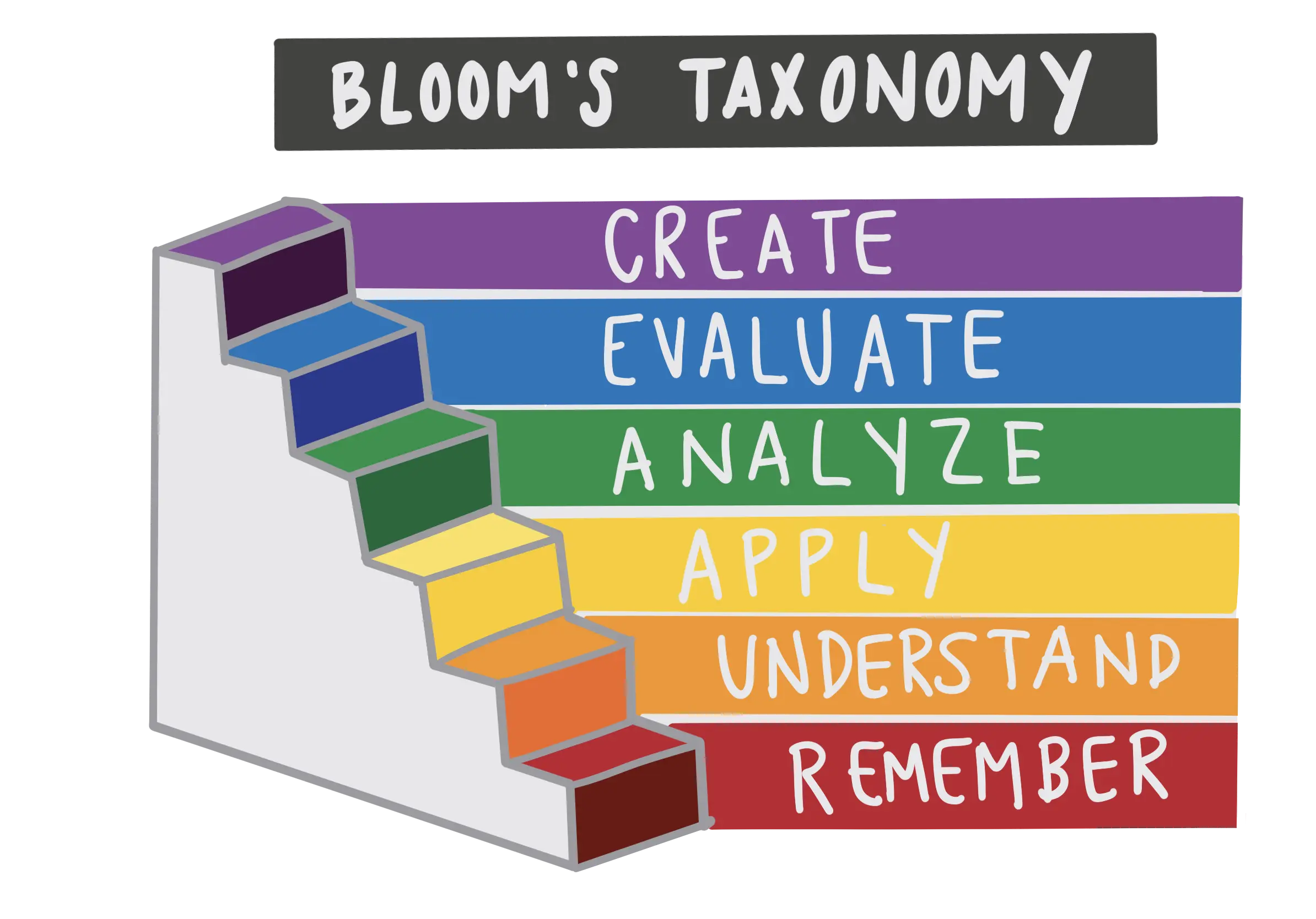A course or training material without learning objectives is like a vehicle without a steering wheel. Both instances spell a lack of direction, and that's a disaster waiting to happen.
For an organization to offer a rich and engaging educational experience, the course content has to incorporate the relevant objectives. This helps with efficient instructional design, enhances learning, and, most importantly, serves as a guide for the trainer or course creator.
Having clearly defined and outlined learning is essential for the success of any corporate training exercise. For instance, a multinational manufacturing company may conduct training on supply chain management for its mid-level employees. For such a course, the objectives may include knowing how to select and evaluate suppliers and mastering supply chain planning and optimization.
To formulate effective and measurable learning objectives, one has to use Bloom's Taxonomy. Since its discovery, this eLearning development framework has achieved significant success in the learning and education sector. Hence, its relevance to this topic. Continue reading to learn how to write impactful learning objectives with this tried-and-tested formula and get the desired results from training exercises.
What are Learning Objectives?
Learning objectives are fundamental elements in educational planning and assessment, serving as clear, concise statements that describe what learners will be able to do or understand upon completing a course or training session. These objectives are not mere wish lists but are precise, actionable goals that guide both instructors and learners towards a common endpoint.
At their core, learning objectives should be SMART: Specific, Measurable, Achievable, Relevant, and Time-bound. This approach ensures that the objectives are not only well-defined but also practical and attainable within a given timeframe.
A well-structured learning objective typically comprises an action verb, a detailed description of the skill or knowledge to be acquired, and a criterion for how learning will be assessed.
For instance, an objective stating, "By the end of this course, students will be able to analyze various economic theories and apply them to current market trends," not only sets a clear expectation but also provides a measurable outcome.
The inclusion of verbs like "analyze" and "apply" offers a concrete indication of the cognitive processes involved, aligning seamlessly with Bloom's Taxonomy, a widely recognized hierarchical model used to classify educational learning objectives into levels of complexity and specificity.
In essence, well-crafted learning objectives are the backbone of effective teaching and learning, providing a roadmap for educational success. They enable educators to design their courses strategically and help students to focus their efforts on achieving clearly defined goals, ultimately leading to a more engaged and fruitful learning experience.
Structuring Learning Objectives with Bloom's Taxonomy

Bloom's Taxonomy is an instructional design framework that categorizes learning outcomes or objectives in a hierarchy-based structure. The original version of this model was developed in 1956 by Benjamin Bloom and his colleagues. Since then, Bloom’s Taxonomy has been revised several times.
The core of this framework is the classification of various cognitive skills and thought processes that students use when learning. It ranks these abilities in ascending order from the simplest to the most complex.
Instructors or educators also use this model as a guide for creating assessment tools and teaching strategies.
The original version of Bloom’s Taxonomy included the following cognitive skills:
- Knowledge: This is the simplest skill. It entails being able to recall the information you've learned. The action verbs associated with this level include remember, recall, list, name, define, label, select, etc.
- Comprehension: At this stage, the learner/student/trainee understands what they’re learning. The action verbs used in this level include summarise, explain, describe, paraphrase, elaborate, contrast, compare, etc.
- Application: This is the third level in which the learner can use the knowledge of what they've learned to solve problems or execute tasks. The action verbs in this level include demonstrate, implement, design, build, utilize, perform, etc.
- Analysis: The trainee is able to break down the information into separate parts and explain how they interact with each other. Examples of action verbs in this level include organize, classify, differentiate, deconstruct, etc.
- Synthesis: This is an advanced stage where the learner can combine parts of the information to create something unique. Examples of action verbs commonly used for this skill include justify, assess, evaluate, critique, validate, support, etc.
- Evaluation: This is the zenith of learning. Here, the person is able to assess the values of methods and ideas. The action verbs in this level include invent, propose, plan, produce, etc.
The modern version of Bloom’s Taxonomy maintains these six levels but with slight changes. The first level, knowledge, is renamed as remembering. The second level is renamed as understanding.
The fifth level is re-listed as the highest level. The belief behind this change is that one must first know how to evaluate information before generating something new from the existing one.
Using Bloom’s Taxonomy to Create Learning Objectives With Examples
It's one thing to know how to write clear educational objectives and another thing to use Bloom's Taxonomy to do that. The following are examples of learning goals (for leadership training) without the inclusion of the framework.
At the end of this module/lesson, the learner should be able to:
- Understand and apply the principles of performance management to enhance individual and team effectiveness
- Identify and demonstrate ethical leadership skills for decision-making in various situations
- Make informed decisions under pressure or duress
- Respond effectively to crises
- Motivate and inspire others to do better
The examples below are a combination of simple learning objectives and Bloom’s Taxonomy for the various cognitive levels:
Remembering
After this module, learners should be able to identify a key leadership figure in human history. The introduction should name the subject, and the body should consist of paragraphs about the leader's journey and achievements during their lifetime. The conclusion refers to their impact while alive and deceased.
Understanding
After this lesson, trainees should be able to explain/describe/elaborate on the core principles of leadership and differentiate between good leadership and bad leadership.
Applying
After this module, learners should be able to demonstrate good leadership skills in a specific scenario (unify and bring the best out of a dysfunctional team/group).
Analyzing
After this lesson, trainees should be able to deconstruct/analyze how (x scenario) was handled by a leader and deduce the skill they used in getting it under control.
Evaluating
After this module, the learners should be able to assess/criticize a given leadership strategy for a specific organizational scenario.
Creating
After this lesson, the trainees should be able to design/propose/plan a leadership training program that addresses certain organizational needs.
The Benefits of Using Bloom’s Taxonomy to Construct Learning Objectives
Here are the reasons Bloom’s Taxonomy has remained relevant in the learning sector for a long time:
- Encourages Critical Thinking: This instructional design structure makes room for higher-order cognitive abilities such as analysis, evaluation, and creation. This helps learners develop or cultivate critical thinking skills, crucial in solving real-world problems and challenges.
- Facilitates the Assessment of Learning Outcomes: The taxonomy makes it easy for one to assess whether the defined learning objectives have been met. The outcome of this evaluation will help trainers or instructors determine how effective their teaching methods have been. This creates room for improvements that will result in an enhanced educational experience.
- Enables Clarity in Communication With the Target Audience: With the incorporation of this instructional model, learners can easily identify the objectives of the course or training exercise. This makes their educational journey easier and more transparent because they know what they expect to learn.
- Progressive Skill Development: It was mentioned earlier that the taxonomy has a hierarchy of cognitive skills starting from the simplest to the most complex ability. In a real learning setting, the trainers can gradually progress with the students in a sequence. The learners first establish foundational knowledge before proceeding to more advanced abilities. It encourages students to learn at their own pace.
- Adaptable to Diverse Subjects: Bloom’s Taxonomy is versatile and can be used in various disciplines to create effective assessment tools, teaching methods, and learning objectives.
- It Prepares One for Lifelong Learning: With this model, learning never stops at remembering or understanding a piece of information. It extends to ongoing processes in which the learners view the knowledge from different perspectives and watch it evolve.
Tips to Write Learning Objectives
To get the best of one’s corporate training exercise, formulate the educational goals with the following things in mind:
- Use Action Verbs: The instructor should include the relevant action verb while formulating the learning goal. This means the verb that describes the skill expected from the learner at a certain level. For instance, if the student is at the “understanding’ phase, relevant verbs will be words like describe or explain.
- Set Clear and Specific Goals: At the end of every module or lesson and the course itself, there should be clear expectations of the learning outcomes. This eliminates room for confusion and creates a standard by which the effectiveness of that training will evaluated. For example, "students should be able to understand the principles of project management” is a vague objective. “Students should be able to create a project timeline using a renowned PM software” is specific and clear.
- Alignment with the Goals of the Training Exercise: The lesson or module objectives must serve the ultimate goal of the corporate training program. If an organization is training its employees on how to improve their customer service, the lesson goal should be in that direction. For instance, one can say. "Using effective communication techniques, demonstrate how you’ll address a customer’s inquiries or concerns.”
- Use the ABCD Model: ABCD stands for Audience, Behaviour, Condition, and Degree. To create learning objectives, first pinpoint the target audience. Secondly, specify the observable behaviour (action verb). Thirdly, outline the conditions under which the behaviour will be displayed. Lastly, define the degree of proficiency expected from the learner. For example, at the end of the training (A), trainees should be able to develop a comprehensive project plan, (B) using a project management software (C), with at least 90% accuracy (D).
Conclusion
Bloom’s Taxonomy has always been useful in creating clear, relevant, and measurable learning objectives for a corporate training exercise.
To recap, the taxonomy has six levels the learner must progress through to meet their learning objectives. They include remembering, understanding, applying, analyzing, evaluating, and creating.
With this instructional framework, the employees won't just have the foundational knowledge needed but the crucial cognitive skills to apply it.
%201.svg)


.png)






%201.svg)